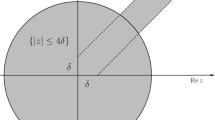Abstract
The current methods for designing periodic orbits in the elliptic restricted three-body problem (ERTBP) have the disadvantages of targeting limited orbits and ergodic searches and considering only symmetric orbits. A universal method for designing periodic orbits is proposed in this paper. First, the homotopy classes of orbits are structured based on their topological structures. Second, a dynamic model based on homotopy classes, ranging from the circular restricted three-body problem (CRTBP) to the ERTBP, can be built using the homotopy method. Third, a multi- and a single-period orbit were selected based on the resonance ratios. Finally, the corresponding orbit in the ERTBP was computed by modifying the initial condition of the orbit in the CRTBP. This method, without an ergodic search, can extend to any orbit, including an asymmetric orbit in the CRTBP, to the ERTBP model, and the two orbits are of the same homotopy class. Examples of the Earth–Moon ERTBP are presented to verify the efficiency of this method.

Similar content being viewed by others
Abbreviations
- a 12 :
-
semi-major axis of primaries
- CRTBP:
-
circular restricted three-body problem
- e :
-
eccentricity in the orbital model
- ERTBP:
-
elliptic restricted three-body problem
- f :
-
true anomaly of primaries
- ME-Halo:
-
multi-revolution elliptic halo
- r 12(f):
-
instantaneous distance between two primaries
- RTBP:
-
restricted three-body problem
- T C, T E :
-
orbital period in the dynamical model of CRTBP and ERTBP, respectively
- W (γ, p):
-
winding number of an orbit about the point p
- Θ:
-
cumulative angle of the rotating system turn relative to the inertial frame
- μ :
-
mass ratio parameter
References
Russell, R. P. Survey of spacecraft trajectory design in strongly perturbed environments. Journal of Guidance, Control, and Dynamics, 2012, 35(3): 705–720.
Broucke, R. Stability of periodic orbits in the elliptic, restricted three-body problem. AIAA Journal, 1969, 7(6): 1003–1009.
Katsiaris, G. The three-dimensional elliptic problem. In: Recent Advances in Dynamical Astronomy. Tapley, B. D., Szebehely, V., Eds. Dordrecht, the Netherlands: Springer, 1973: 118–134.
Sarris, E. Families of symmetric-periodic orbits in the elliptic three-dimensional restricted three-body problem. Astrophysics and Space Science, 1989, 162(1): 107–122.
Biggs, J. D., Waters, T., McInnes, C. New periodic orbits in the solar sail three-body problem. In: Nonlinear Science and Complexity. Dordrecht, the Netherlands: Springer, 2011: 131–138.
Robin, I. A. Bifurcations of plane with three-dimensional periodic orbits in the elliptic restricted problem. Celestial Mechanics, 1981, 23(1): 97–106.
Ollé M, Pacha J R. The 3D elliptic restricted three-body problem: Periodic orbits which bifurcate from limiting restricted problems. Complex instability. Anesthesiology, 1999, 351: 1149–1164.
Kotoulas, T. A. The dynamics of the 1:2 resonant motion with Neptune in the 3D elliptic restricted three-body problem. Astronomy & Astrophysics, 2005, 429(3): 1107–1115.
Hou, X. Y., Liu, L. On motions around the collinear libration points in the elliptic restricted three-body problem. Monthly Notices of the Royal Astronomical Society, 2011, 415(4): 3552–3560.
Peng, H., Xu, S. Stability of two groups of multi-revolution elliptic halo orbits in the elliptic restricted three-body problem. Celestial Mechanics and Dynamical Astronomy, 2015, 123(3): 279–303.
Ferrari, F., Lavagna, M. Periodic motion around libration points in the elliptic restricted three-body problem. Nonlinear Dynamics, 2018, 93(2): 453–462.
Sabzy, S., Daneshjou, K., Bakhtiari, M. Periodic attitude motions along planar orbits in the elliptic restricted three-body problem. Advances in Space Research, 2021, 67(8): 2252–2273.
Gurfil, P., Meltzer, D. Stationkeeping on unstable orbits: Generalization to the elliptic restricted three-body problem. The Journal of the Astronautical Sciences, 2006, 54(1): 29–51.
Koh, D., Anderson, R. L. Periodic orbit-attitude solutions in the planar elliptic restricted three-body problem. Journal of Guidance, Control, and Dynamics, 2008, 41(3): 644–657.
Voyatzis, G., Kotsialos, T., Hadjidemetriou, J. Computation of asymmetric periodic configurations in the three-body problem. In: Proceedings of the 2nd International Conference From Scientific Computing to Computational Engineering, Athens, 2006.
Szebehely, V. Theory of Orbit. Elsevier, 1967: 653–655.
Zhang, W. Trajectory design and optimization for cycler architecture. Doctoral Dissertation. Beijing: Beijing Institute of Technology, 2015. (in Chinese)
Mioc, V., Anisiu, M. C., Barbosu, M. Symmetric periodic orbits in the anisotropic Schwarzschild-type problem. Celestial Mechanics and Dynamical Astronomy, 2005, 91(3–4): 269–285.
Huggett, S., Jordan, D. A Topological Aperitif. Springer, 2001.
Belbruno, E., Topputo, F., Gidea, M. Resonance transitions associated to weak capture in the restricted three-body problem. Advances in Space Research, 2008, 42(8): 1330–1351.
Armstrong, M. A. Basic Topology. New York: Springer, 1979.
Voyatzis, G., Gkolias, I., Varvoglis, H. The dynamics of the elliptic hill problem: Periodic orbits and stability regions. Celestial Mechanics and Dynamical Astronomy, 2012, 113(1): 125–139.
Peng, H., Xu, S. Numerical stability study of multi-circle elliptic halo orbit in the elliptic restricted three-body problem. In: Proceedings of the 24th International Symposium on Space Flight Dynamics, Luarel, USA, 2014: 1–20.
Peng, H., Bai, X., Xu, S. Continuation of periodic orbits in the Sun–Mercury elliptic restricted three-body problem. Communications in Nonlinear Science and Numerical Simulation, 2017, 47: 1–15.
Acknowledgements
The authors gratefully acknowledge financial support from the Natural Science Basic Research Program of Shaanxi (Grant No. 2021JQ-846) and the Science Research Fund of Xi’an Aeronautics University (Grant No. 2020KY2236).
Author information
Authors and Affiliations
Corresponding author
Ethics declarations
The authors have no competing interests to declare that are relevant to the content of this article.
Additional information
Yue Zheng received her Ph.D. degree from the School of Astronautics at Northwestern Polytechnical University, China. She is now a teacher in the School of Electronic Engineering at Xi’an Aeronautical Institute, China. Her research interests include aircraft orbit design, astrodynamics, and machine learning. E-mail: 2012100018@mail.nwpu.edu.cn
Rights and permissions
About this article
Cite this article
Zheng, Y., Zhao, M. Universal method for designing periodic orbits by homotopy classes in the elliptic restricted three-body problem. Astrodyn 8, 175–188 (2024). https://doi.org/10.1007/s42064-023-0188-y
Received:
Accepted:
Published:
Issue Date:
DOI: https://doi.org/10.1007/s42064-023-0188-y




